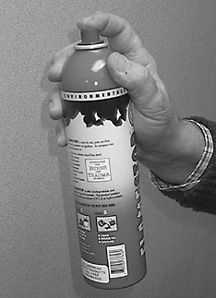There are some things you can’t have too many of. Fire extinguishers are a good example. A fire extinguisher is most effective when a fire is first getting underway, which means that an extinguisher should be located near the most likely spots for a fire to start, such as the galley and the engine room. (Never mount it where you would have to reach through flames to get to it, such as behind a galley stove.)

Flamestop is a fairly recent addition to the ranks of fire-extinguishing equipment, and it’s intended for just that type of first-line defense.
Flamestop is a pressurized, water-based surfactant system packaged in a conventional-looking aerosol-type container. It measures 2.5″ in diameter and stands 10.5″ tall, holding 16 oz. of liquid. The spray is powered by compressed air and is easily controllable up to about a foot from the fire — instructions call for holding back 6-7″.
To operate the Flamestop extinguisher, you pop off a plastic cap and press a button (which could be more plainly marked as to the direction of spray). When you release the button, the spray stops, and the fire extinguisher can be reused.
We’re a bit dubious about the reusability concept. The manufacturer claims a total of 30 seconds of spray time. In our tests it varied between 17 and 28 seconds, so unless you’re a compulsive record keeper who takes a stopwatch to a galley fire, you’ll have very little idea of what’s left for the next time.
While we’re considering the Flamestop’s downside, we should point out that as of now, there’s no mounting bracket available for it. You have to stow it on a shelf or drawer, which doesn’t provide the ready accessibility a fire extinguisher should have.
The good news is that Flamestop worked very well in our tests. It put out grease fires and a wood fire quickly and effectively. The spray of pinkish stream was easy to direct. The spray continued regardless of the can’s position and orientation. One not-so-obvious advantage that Flamestop has over similarly priced dry chemical extinguishers (see PS, August 15, 2001) is that it’s not intimidating to use. There’s no cloud of white powder and no messy cleanup. Flamestop cleans up readily with soap and water. As a consequence, many people will be less hesitant to use the Flamestop as soon as a fire starts.
We don’t recommend Flamestop as a replacement for a more conventional extinguisher. The lack of a mounting bracket and of any indication of how full a reused container may be militates against any such recommendation. Flamestop should be regarded as a first-line supplement to the more familiar dry-chemical extinguishers.
At a modest $14.95 MSRP, it will pay to have a couple of these stowed strategically about the boat.
Contacts
All-American Safety Products, 866/909-6525, www.allamericansafety.com

































